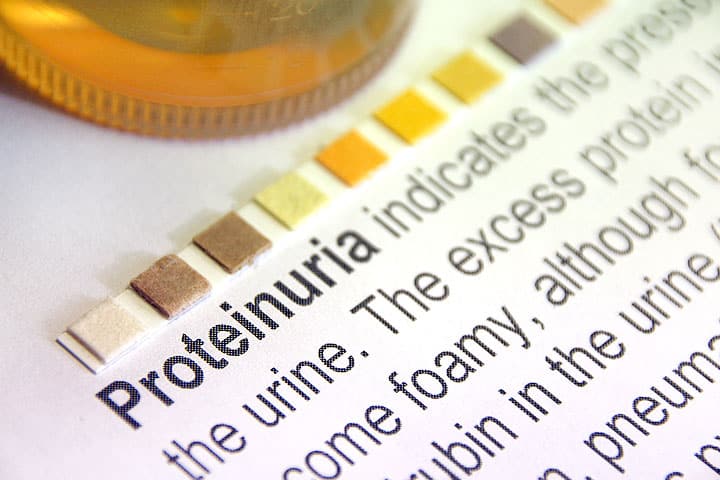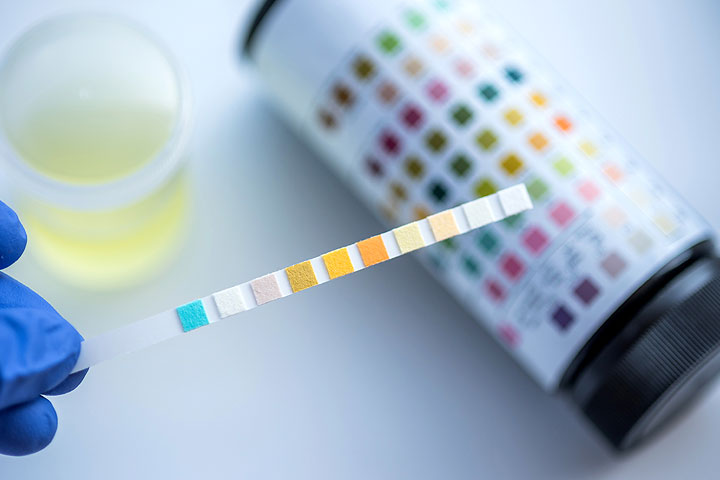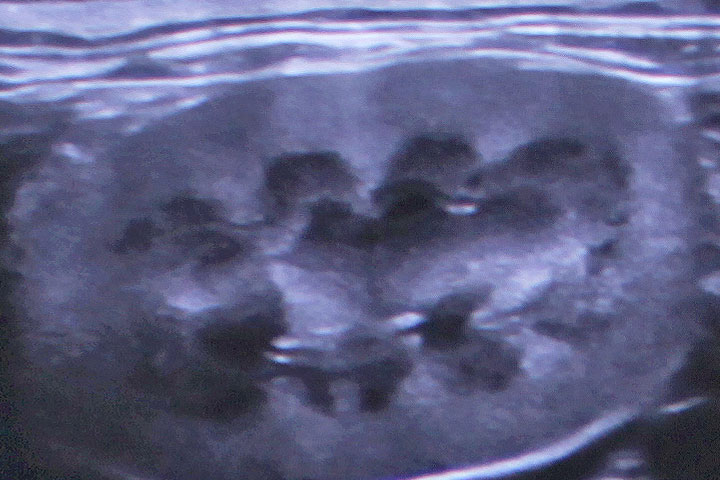
Internal Medicine
Proteinuria
How do we measure it, and what are the pros and cons of the options?
Proteinuria is most commonly assessed using dipsticks, or submitting the sample for a urine protein: creatinine ratio (UPCR).
Dipstick tests are cheap, and easy, but unfortunately are prone to inaccuracies. False negative results can occur in Bence-Jones proteinuria, or with dilute or acidic urine. False positive results are common- particularly in cats (when a positive result is defined as ‘trace’ or more).
- Dogs: sensitivity (positive results correctly identified by dipstick) 81%, specificity (negative results correctly identified by dipstick) 48%
- Cats: sensitivity 90%, specificity 11%. As you can see, false positives results are very commonly seen when assessing feline urine samples for proteinuria with dipsticks. The recommendation is thus to always check for proteinuria in feline samples by another method (UPCR).
UPCRs are a much more accurate method of quantifying proteinuria. There is variation in the values seen within a 24hr cycle though, so the recommendation is to collect three urine samples, and mix them, to create an average urine sample on which to check the UPCR. Due to this variation, UPCR changes of around 80% at low levels (UPCR near 0.5), or 35% at high levels (UPCR near 12) are required to be confident that sequential values taken for monitoring represent genuine changes.
What causes proteinuria?
- Proteinuria can occur due to pre-renal, renal or post-renal causes. Pre-renal proteinuria is caused by increased concentrations of low molecular weight proteins are present in the blood, which are then filtered by the glomeruli and cause proteinuria. Biochemistry to check globulin levels can rule pre-renal causes in or out.
- Post-renal proteinuria is due to pathology in the lower urinary tract or genital tract. An active urine sediment (inflammation, infection etc) can cause proteinuria, however the effect of haematuria and pyuria on UPCR is very variable.
Animals without hyperproteinemia, who have a silent urine sediment, can be diagnosed with renal proteinuria. Renal proteinuria can be physiologic/benign secondary to fever, strenuous exercise, seizures etc, or it can be pathological, in which case it would be expected to be persistent. Persistent proteinuria is worthy of further consideration, particularly at higher levels.
Persistent renal proteinuria is typically glomerular in origin, although low level proteinuria (UPCR4.0) is almost always glomerular in origin. The glomerular pathology can be secondary – due to hypertension, or immune complexes settling in the glomeruli from infectious/inflammatory or neoplastic disease elsewhere in the body. It is thus important to check for hypertension or other diseases commonly associated with proteinuria (hyperadrenocorticism and leishmania for instance) before settling upon a primary glomerular pathology as the cause of the renal proteinuria. Also important to consider is that while hypertension can cause proteinuria, glomerular diseases can also cause hypertension, and thus it is important to try to determine which is the chicken and which is the egg!
When UPCR is significantly elevated (>2.0), and the problem looks to be primary renal, renal biopsy is the ideal next step. Renal biopsies can be performed using minimally invasive ultrasound-guided Trucut techniques. Optimising the information available from the samples requires complicated sample preparation, and electron microscopy and immunostaining in addition to ‘normal’ light microscopy. If you have a case that you think would benefit from this diagnostic technique, please don’t hesitate to call to discuss the possibility further with one of our medicine team.
When should I worry?
Ongoing proteinuria risks tubular damage, and development/progression of azotaemia. In patients with known chronic kidney disease, UPCR >0.4 (cats) and >0.5 (dogs), should be treated. In non-azotaemic patients, the cut-off for intervention is considered to be higher by many clinicians: UPCR >1.0-2.0 considered appropriate for investigation and intervention.
Nephrotic syndrome (proteinuria, hypoalbuminemia, hypercholesterolemia, presence of subcutaneous oedema/effusion) can develop in proteinuria, but is relatively infrequent. Predicting the risk of nephrotic syndrome in proteinuria is very difficult, with an inconsistent relationship between UPCR level and the presence of nephrotic syndrome.


Case Advice or Arranging a Referral
If you are a veterinary professional and would like to discuss a case with one of our team, or require pre-referral advice about a patient, please call 01883 741449. Alternatively, to refer a case, please use the online referral form